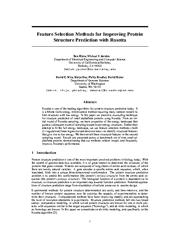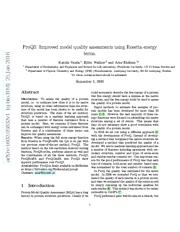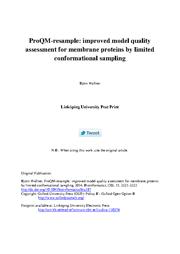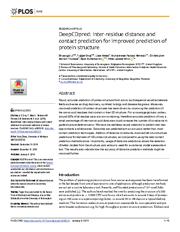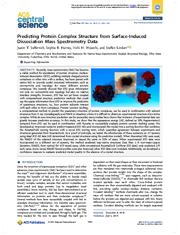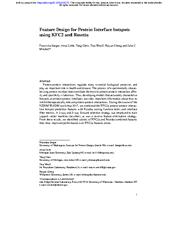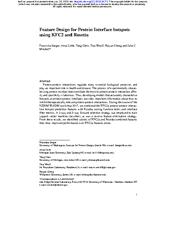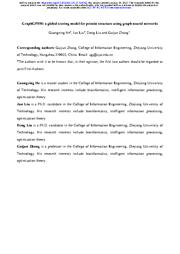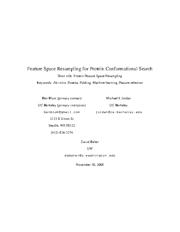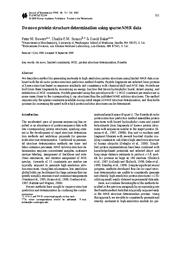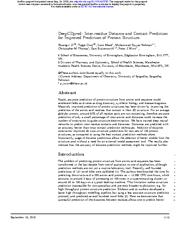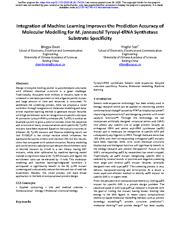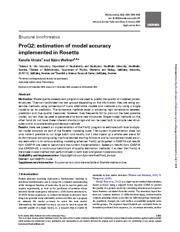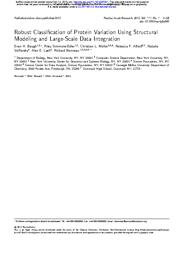A copy of this work was available on the public web and has been preserved in the Wayback Machine. The capture dates from 2016; you can also visit the original URL.
The file type is application/pdf.
Filters
Feature Selection Methods for Improving Protein Structure Prediction with Rosetta
2007
Neural Information Processing Systems
Rosetta is one of the leading algorithms for protein structure prediction today. It is a Monte Carlo energy minimization method requiring many random restarts to find structures with low energy. ...
In this paper we present a resampling technique for structure prediction of small alpha/beta proteins using Rosetta. ...
Structure prediction methods fall into two broad camps: comparative modeling, in which solved protein structures are known for one or more proteins with sequences similar to the target sequence ("homologs ...
dblp:conf/nips/BlumJKDBB07
fatcat:eknti2s3sbc3ndz6voqsowpus4
ProQ3: Improved model quality assessments using Rosetta energy terms
[article]
2016
arXiv
pre-print
Here, we examine if these features can be exchanged with energy terms calculated from Rosetta and if a combination of these terms can improve the quality assessment. ...
structure prediction. ...
Acknowledgements We thank Nanjiang Shu for valuable discussions.
Funding This work was supported by grants from the Swedish Research Council (VR-NT 2012-5046 to AE and 2012-5270 to BW). ...
arXiv:1602.05832v1
fatcat:jor7ezxv6bd37ibjoajxamtexy
ProQM-resample: improved model quality assessment for membrane proteins by limited conformational sampling
2014
Computer applications in the biosciences : CABIOS
It can be used to guide and explain experiments, as well as for prediction of proteins whose structure, in particular for membrane proteins, for the most part is unknown ($0.5% membrane protein in the ...
While all structural features such as atom-atom contacts, residue-residue contacts, surface areas and secondary structures, as well as the SVM prediction are calculated by Rosetta during scoring, there ...
doi:10.1093/bioinformatics/btu187
pmid:24713439
pmcid:PMC4103597
fatcat:5gsyoi6ho5c2bczs5ogbnjymee
DeepCDpred: Inter-residue distance and contact prediction for improved prediction of protein structure
2019
PLoS ONE
Addition of distance constraints improved de novo structure predictions for test sets of 158 protein structures, as compared to using the best contact prediction methods alone. ...
Massively improved prediction of protein structures has been driven by improving the prediction of the amino acid residues that contact in their 3D structure. ...
Acknowledgments We would like to thank to University of Birmingham for providing the access to BlueBEAR HPC service and covering open access publishing costs.
Author Contributions ...
doi:10.1371/journal.pone.0205214
pmid:30620738
pmcid:PMC6324825
fatcat:bfcqi4s5y5fupcblhemztq4u4i
Predicting Protein Complex Structure from Surface-Induced Dissociation Mass Spectrometry Data
2019
ACS Central Science
However, SID has not yet been coupled with computational structure prediction methods that could use the sparse information from SID to improve the prediction of quaternary structures, i.e., how protein ...
Recently, mass spectrometry (MS) has become a viable method for elucidation of protein structure. ...
■ ACKNOWLEDGMENTS We thank the members of the Lindert lab for many useful discussions. ...
doi:10.1021/acscentsci.8b00912
pmid:31482115
pmcid:PMC6716128
fatcat:r6jdkmse4fcrdkfu2drpl7aqnq
Feature Design for Protein Interface Hotspots Using KFC2 and Rosetta
[chapter]
2019
Association for Women in Mathematics Series
During the course of the ICERM WiSDM workshop 2017, we combined the KFC2a protein-protein interaction hotspot prediction features with Rosetta scoring function terms and interface filter metrics. ...
From these results, we identified subsets of KFC2a and Rosetta combined features that show improved performance over KFC2a features alone. ...
In this work, we will add features from Rosetta to those of KFC2 and train an improved model for protein-protein hotspot prediction. ...
doi:10.1007/978-3-030-11566-1_8
fatcat:acc6nq7vbbaz7b4vrvbejbuqai
Feature Design for Protein Interface hotspots using KFC2 and Rosetta
[article]
2019
bioRxiv
pre-print
During the course of the ICERM WiSDM workshop 2017, we combined the KFC2a protein-protein interaction hotspot prediction features with Rosetta scoring function terms and interface filter metrics. ...
From these results, we identified subsets of KFC2a and Rosetta combined features that show improved performance over KFC2a features alone. ...
In this work, we will add features from Rosetta to those of KFC2 and train an improved model for protein-protein hotspot prediction. ...
doi:10.1101/514372
fatcat:ufcl3tt6qzfw5g3tz5eejscglq
GraphGPSM: a global scoring model for protein structure using graph neural networks
[article]
2023
bioRxiv
pre-print
These two features are combined with Rosetta energy terms, backbone dihedral angles, and inter-residue distance and orientations to represent the protein model and embedded into the nodes and edges of ...
The scoring models used for protein structure modeling and ranking are mainly divided into unified field and protein-specific scoring functions. ...
Then, about 60 structure models are selected in accordance with the Rosetta energy of the perturbed structures. ...
doi:10.1101/2023.01.17.524382
fatcat:jznz7cae3fawpbf2mr7fswi6lq
Genetic algorithm feature-based resampling for protein structure prediction
2010
IEEE Congress on Evolutionary Computation
numerous months even years to produce a predicted structure for a target protein. ...
Computational protein structure prediction (PSP) methods have been introduced to speed up the PSP process due to manual methods, like nuclear magnetic resonance (NMR) and x-ray crystallography (XC) taking ...
A basic example of feature-based resampling can be seen as having a predicted protein structure with one domain wrong, but by intermixing this protein with another protein, which has the other correct ...
doi:10.1109/cec.2010.5586149
dblp:conf/cec/HiggsSHS10
fatcat:6yiazgsknjhwnbqik257o6rvbm
Feature space resampling for protein conformational search
2010
Proteins: Structure, Function, and Bioinformatics
We show that native features can be predicted at much higher than background rates, and that using the predicted feature distributions improves structure prediction in a benchmark of 28 proteins. ...
We begin with a large number of conformations generated in independent Monte Carlo structure prediction trajectories from Rosetta. ...
We also wish to acknowledge support to MIJ from the Miller Institute for Basic Research in Science. ...
doi:10.1002/prot.22677
pmid:20131376
pmcid:PMC2854516
fatcat:mv2aougztjhpvjyfb2fvigpdea
De novo protein structure determination using sparse NMR data
2000
Journal of Biomolecular NMR
We describe a method for generating moderate to high-resolution protein structures using limited NMR data combined with the ab initio protein structure prediction method Rosetta. ...
The method requires only the sparse constraints available during initial stages of NMR structure determination, and thus holds promise for increasing the speed with which protein solution structures can ...
structures. ...
pmid:11200525
fatcat:fob24e35rve5didjdl6ck3eiri
DeepCDpred: Inter-residue Distance and Contact Prediction for Improved Prediction of Protein Structure
[article]
2018
bioRxiv
pre-print
Addition of distance constraints improved de novo structure predictions for test sets of 158 protein structures, as compared to using the best contact prediction methods alone. ...
Massively improved prediction of protein structures has been driven by improving the prediction of the amino acid residues that contact in their 3D structure. ...
For all other prediction methods, models were 353 selected either with the lowest Rosetta energy or the best TM-score. The calculations 354 were performed for the test set of 108 proteins. ...
doi:10.1101/425785
fatcat:hetr4rbtnnbndloht7ioipy7d4
Integration of Machine Learning Improves the Prediction Accuracy of Molecular Modelling for M. jannaschii Tyrosyl-tRNA Synthetase Substrate Specificity
[article]
2020
bioRxiv
pre-print
Design of enzyme binding pocket to accommodate substrates with different chemical structure is a great challenge. ...
ratio for recognition of specific substrate. ...
For example, improved score function of molecular docking software 19 , improved protein design performance 20 and accurate prediction of thermostability for protein mutants 21 have been achieved ...
doi:10.1101/2020.06.26.174524
fatcat:3mrufzviovfahllkc67out2vcm
ProQ2: estimation of model accuracy implemented in Rosetta
2016
Bioinformatics
Motivation: Model quality assessment programs are used to predict the quality of modeled protein structures. ...
Single-model methods on the other hand do not have these inherent shortcomings and can be used both to sample new structures and to improve existing consensus methods. ...
For example, one such feature is predicted secondary structure agreement with the actual secondary structure in the model, and there is also a similar feature for predicted surface accessibility. ...
doi:10.1093/bioinformatics/btv767
pmid:26733453
pmcid:PMC4848402
fatcat:cagedpzfwbb5bkp34ycppx3wwi
Robust Classification of Protein Variation Using Structural Modeling and Large-Scale Data Integration
[article]
2015
bioRxiv
pre-print
To train VIPUR, we collected 9,477 protein variants with known effects on protein function from multiple organisms and curated structural models for each variant from crystal structures and homology models ...
Existing methods for interpreting protein variation focus on annotating mutation pathogenicity rather than detailed interpretation of variant deleteriousness and frequently use only sequence-based or structure-based ...
ACKNOWLEDGEMENTS We would like to thank the Simons Foundation, specifically the Simons Foundation Autism Research Initiative and the Simons Center for Data Analysis, and NYU-ITS, specifically Muataz Al-Barwani ...
doi:10.1101/029041
fatcat:e2lvnhljtrdh5lcaknwqxlrlya
« Previous
Showing results 1 — 15 out of 6,257 results

